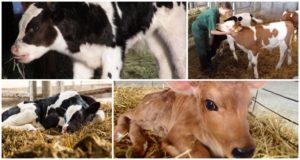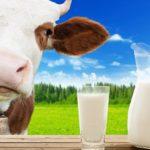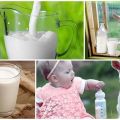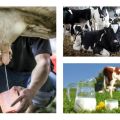When after calving a cow can you drink milk and how many days does colostrum go
Cow's milk is of great benefit to people. This product contains a large number of proteins that contribute to the formation of new cells. Also, the drink contains vitamins and other valuable substances. Homemade milk is the most beneficial. At the same time, not everyone knows when to start drinking milk after a cow has calved. Doing this is not permissible right away.
How much colostrum does a cow have?
Immediately after giving birth, the cow excretes colostrum. It is a liquid with a yellow tint and a viscous consistency. This mass contains many natural immunomodulating agents and beneficial elements that are important for the baby. The product includes proteins, fats, carbohydrates, vitamins, minerals. For the first couple of hours, the calf lays on the udder and helps to milk the milk.
The abomasum is considered the most developed proventriculus in the calf. It is into it that milk from the esophagus enters. This section holds approximately 1.5 liters of colostrum. With a larger volume, there is a risk of indigestion. Thus, the calf is fed for at least a week.
Gradually, colostrum turns into milk in composition. After 10 days, it takes on the usual composition. For the distribution of animals, having a baby nearby is of great importance. This is very important for first-calf heifers. Newborn cubs develop the udder and drink milk for 5-6 days. However, they will not be able to suck everything out. The more liquid comes out, the more it appears.
It is important to consider that if milk remains in the udder, it becomes rancid and decreases in volume.
It is not recommended to consume pure colostrum. It is characterized by high fat content. The composition of the product is especially suitable for babies. Some people bake the mass in the oven because of its nutritional value.

How to milk a cow correctly
To get more milk out of the cow, it is important to properly distribute it. It is worth preparing for this process by increasing the volume of feed. At the same time, it is recommended to do this immediately after mating. Improved nutrition helps to store nutrients and prepare for childbirth.
The udder of a cow is very sensitive, therefore it is recommended to massage it very carefully. This helps to achieve good lactation. To protect the skin from microdamage, it is recommended to use special ointments.
To distinguish colostrum from mature milk, it is recommended to heat it at an elevated temperature. It should be borne in mind that colostrum curdles, but milk does not. Particular attention should be paid to primiparous cows that are not adapted to milking. Extreme caution and patience should be exercised with these animals.

Milk volume from cow after calving
A number of factors affect the performance of a cow. These include nutrition, care, breed. Age and even the season are important. In winter, lactation is less. Therefore, the pregnancy of cows is usually planned for the winter. Farmers claim that primiparous individuals bring 7-9 liters of milk. Cows reach the highest level of productivity by 4-5 lactation. During this time, they, on average, produce 12 liters of milk. It is of high quality and contains many proteins and fats. You can even cook cheese from it.
The most productive are Yaroslavl and Holstein cows, which produce up to 40 liters of milk per day.
To increase milk yield, it is recommended to use the following methods:
- provide animals with a balanced diet, since large individuals bring a lot of milk;
- if necessary, it is permissible to introduce vitamins and minerals into the menu;
- monitor the temperature regime - it should be at least +5 degrees and not more than +20;
- ensure silence in the room - intense noise negatively affects productivity parameters;
- remove horns from animals - this will help avoid a lack of selenium, which is spent on the growth of horns, improve the condition of the body and increase productivity parameters;
- take good care of the animals and walk them systematically.
Possible problems
Sometimes certain difficulties appear during lactation. Common problems include:
- Low milk yield. They are caused by poor milking technique or health problems. In such a situation, it is recommended to milk the cows strictly according to the schedule, regularly massage the udder, observe sanitary rules, and introduce food into the diet to stimulate lactation. If this does not give an effect, it is worth suspecting problems in the functioning of the body. In such a situation, the help of a veterinarian is required.
- Lack of milk. This is a more difficult situation called agalactia. It is caused by inflammation, impaired milk return reflex or lack of nutrition. During pregnancy, many important processes take place in the body. They make the body weaker. Your veterinarian will help you eliminate serious health problems. Sometimes it is enough to make adjustments to the diet and improve the conditions of the pet.
- Swelling of the udder. There are situations when blood circulation and lymph circulation are impaired in the udder. This leads to the appearance of puffiness. The problem is caused by an excess of acidic and juicy feed in the diet and a deficiency in physical activity. If the swelling does not go away within a week after giving birth, the help of a veterinarian is needed.
It is permissible to eat milk about a week after calving. At the same time, many different factors affect its quantity. These include conditions of detention, diet, breed, age, health status of the animal. If you take good care of the cow, her milk yield will remain consistently high.












